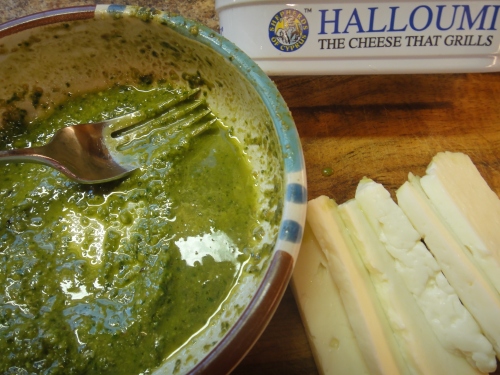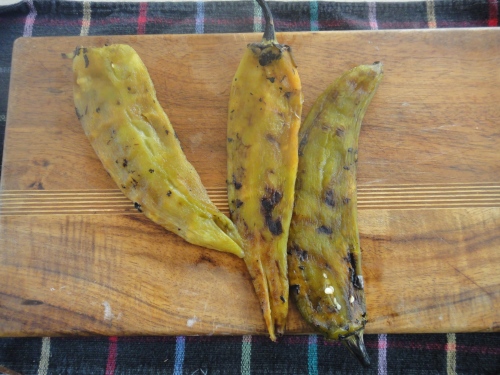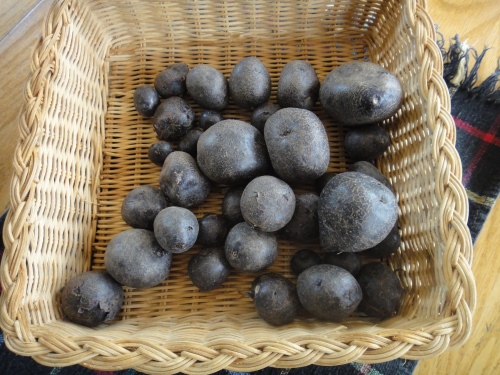 I’ve heard, though it’s not my recent personal experience, that state fair food vendors have gone wild. Forget corn dogs. These days you can sample even more than deep-fried ice cream and brownies. Deep fried-watermelon anyone? Or Thanksgiving dinner—turkey, stuffing and creamed corn fried in a ball? I wonder if there is a carnival food truck that deep-fries halloumi. Hear that fair food vendors? You could be the first! Halloumi cheese can handle the heat.
I’ve heard, though it’s not my recent personal experience, that state fair food vendors have gone wild. Forget corn dogs. These days you can sample even more than deep-fried ice cream and brownies. Deep fried-watermelon anyone? Or Thanksgiving dinner—turkey, stuffing and creamed corn fried in a ball? I wonder if there is a carnival food truck that deep-fries halloumi. Hear that fair food vendors? You could be the first! Halloumi cheese can handle the heat.
 It’s not as if the trendy cheese was just invented. Mediterranean peasants have been enjoying this firm goat and sheep milk cheese with for centuries. Worldly foodies are long in the know, I’m simply late to the party. I’ve read about halloumi and I’ve come across recipes, thinking I should try it, but it was only this summer that I finally got around to grilling halloumi.
It’s not as if the trendy cheese was just invented. Mediterranean peasants have been enjoying this firm goat and sheep milk cheese with for centuries. Worldly foodies are long in the know, I’m simply late to the party. I’ve read about halloumi and I’ve come across recipes, thinking I should try it, but it was only this summer that I finally got around to grilling halloumi.
Kalyn over at Kalyn’s Kitchen convinced me. It was her recipe for Grilled Halloumi Cheese, Mushrooms and Sweet Onion Skewers that sent me shopping for the unusual cheese.
 I have yet to try her skewers. For my first go, I brushed halloumi with basil pesto sauce and grilled it alongside some par-boiled potatoes. Yummy!
I have yet to try her skewers. For my first go, I brushed halloumi with basil pesto sauce and grilled it alongside some par-boiled potatoes. Yummy!
 The next week I took Robbie to dinner at Deer Valley Grocery~Café. There it was on the tapas menu; halloumi, pan-seared, and served with Spanish Marcona almonds that were gooey with Slide Ridge Honey and sprinkled with fresh thyme, on top of tangy sherry “tar.” But the cheese wasn’t actually halloumi. It was local, Heber Valley artisanal Juustoleipa cheese, a Northern European version of grillable cheese, made from cow’s milk. Maybe because it comes from just over the mountain, I think the local cheese is sweeter and more creamy than imported halloumi. I found Heber Valley Juustoleipa in the same section as Greek halloumi at the market, three blocks from our house.
The next week I took Robbie to dinner at Deer Valley Grocery~Café. There it was on the tapas menu; halloumi, pan-seared, and served with Spanish Marcona almonds that were gooey with Slide Ridge Honey and sprinkled with fresh thyme, on top of tangy sherry “tar.” But the cheese wasn’t actually halloumi. It was local, Heber Valley artisanal Juustoleipa cheese, a Northern European version of grillable cheese, made from cow’s milk. Maybe because it comes from just over the mountain, I think the local cheese is sweeter and more creamy than imported halloumi. I found Heber Valley Juustoleipa in the same section as Greek halloumi at the market, three blocks from our house.
 Yukon gold potatoes came in Ranui’s CSA box and New Mexican Hatch chiles are abundant right now and became part of today’s recipe, one that shows off the cheese, a creamy contrast for the chiles and spiced potatoes.
Yukon gold potatoes came in Ranui’s CSA box and New Mexican Hatch chiles are abundant right now and became part of today’s recipe, one that shows off the cheese, a creamy contrast for the chiles and spiced potatoes.
 Yukon Golds, Roasted Green Chiles and Heber Valley “Halloumi”
Yukon Golds, Roasted Green Chiles and Heber Valley “Halloumi”
3 Hatch green chiles
1 pound Yukon Gold potatoes, peeled and cut into ½-inch chunk
2 tablespoons safflower or other “high heat” vegetable oil
1 tablespoon unsalted butter
About ¾ teaspoon Real Salt, to taste
About ¾ teaspoon New Mexican green chile powder, to taste
3 to 4 ounces halloumi or Juustoleipa cheese
Prepare the green chiles:
Roast the chiles on high heat, over an open flame on your stovetop, in your broiler, or on your grill. Cook the peppers, turning often, until they are blistered and blackened on all surfaces, about 3 to 5 minutes for each exposed surface.
Place in a closed plastic baggie or in a casserole dish with a fairly tight lid and let them cool. Cooling will create steam and help the charred skin release from the chiles.
After about 10 minutes, cut off the top of each chile, and peel away the skin. (You might want to discard most of the seeds if you prefer your chiles mild.)
Cut the chiles in strips and set aside.
Cook the potatoes: Place the potatoes in a steamer basket set in a saucepan with water under the steamer basket. Steam until the potatoes are barely tender, about 10 minutes. Pick the basket up out of the saucepan and dump the potatoes in a clean kitchen towel, so that they lose most of their moisture.
Heat a large non-stick skillet over medium high flame. Add the oil and butter. When the butter has melted, add the potatoes and cook, tossing occasionally, until the potatoes are golden on a few sides. Sprinkle to taste with salt and the green chile powder along the way. This will take 15 to 20 minutes.
When the potatoes are golden and crispy, push them to the outer edges of the skillet. Add the green chile strips to the open area in the middle. Let them heat through, and then push them to the outside of the skillet as well.
 Cut the halloumi (or Juustoleipa) cheese in strips about 3/8-inch thick. Place the strips in the middle of the pan and cook until lightly golden on both sides.
Cut the halloumi (or Juustoleipa) cheese in strips about 3/8-inch thick. Place the strips in the middle of the pan and cook until lightly golden on both sides.
Serve immediately.




















